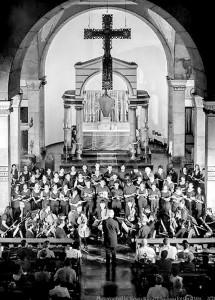St John Passion – A transcendent experience
J.S. Bach’s St. John Passion (highlights) was performed by the Sri Lankan Festival Chorus and the Orchestra of the Chamber Music Society of Colombo (CMSC) on March 28 at St. Paul’s Church, Colombo 10 with Dinushka Jayawickreme (soprano), Alison Wells (alto) and Gregory Rose (conductor).
St Paul’s Church, with its regal dome, high arches and tunnel roof, was the perfect venue for this celebrated oratorio, given the clear acoustics and pleasant ambience. Even though the doors were left open, the soft intermittent street “noise’ failed to distract the audience, for so enthralling was the music. The concert (about 90 minutes long) was preceded by an unexpected cloudburst. But, miraculously, the pelting rain and deafening thunder ceased as nightfall approached. Perhaps Bach had appealed to the heavens from his grave!

Gregory Rose conducts the Festival Chorus in St. John Passion at St. Paul’s Church. Pic by Kesara Ratnavibhushana
Shortly after the deluge, the large four-part choir, dressed in black, entered from the wings and filed neatly into three rows. Then the Passion commenced with an exquisite, one-minute orchestral introduction leading to the vibrant opening chorus. “Herr … herr … herr … un-ser … Herr … scher.” What a rapturous beginning!
It was a pleasure to see the eminent Gregory Rose (who is no stranger to our shores) teaming up with internationally acclaimed composer, Lakshman Joseph de Saram (Artistic Director of the CMSC Ensemble), to present one of the world’s most endearing pieces of music, which is traditionally performed one week before Easter. If the choir and the orchestra had only one week to practise together (due to Rose’s tight international schedule), it did not show.
The Festival Chorus was drawn from several sources, namely Contempo, Colombo Philharmonic, Camerati, Coro Cant Amici, Menaka Singers, Peradeniya Singers, Soul Sounds, Old Joes Choir, Weald Choir, Crawley (UK), and St Paul’s Knightsbridge (UK). The orchestral instruments comprised violins (9), violas (2), violoncellos (3), double basses (2), flutes (2), oboes (2), bassoons (1), and cembalo. The ensemble was probably larger than that used for the Passion almost 300 years ago. (It was first performed in Leipzig in 1724.) It should be noted that some of the instruments used then, such as the viola d’amore, viola de gamba, and lute, have become obsolete. Perhaps the sound is less delicate now than in Bach’s time due to the exit of gamba strings. On the other hand, a bigger and fuller orchestra is likely to give it more depth and resonance.
The singing overall was spot on with the choir showing excellent control of tempi and modulation. And how well it blended with the ensemble, which delivered its usual impeccable performance with Lakshman Joseph de Saram at the helm. The clarity of sound was exemplary, not to mention the dynamic orchestration, which was expertly managed by Gregory Rose. Here is a conductor who commands the respect of his musicians with his precise cues, refined intellect, and artistic flair.
The St John Passion is a technically demanding piece in respect of tempi, range, emotional texture, stamina, and architectural complexity, and to perform it convincingly (in German) with very limited rehearsal time is a near impossible task. Hats off to the choir and the ensemble for pulling it off with poise and élan. The males (tenors and basses), however, were heavily outnumbered by the females (sopranos and altos). Due to this gender imbalance, the male singers (collectively) did not possess the same power as their female counterparts. Be that as it may, it was a fine performance on the whole by the Festival Chorus, which appears to be brimming with talent.
The two soloists were splendid. Young Dinushka Jayawickreme (soprano) is blessed with a mellifluous voice and inborn musicality, while Alison Wells (alto) possesses the ability to captivate the audience with her clear projection and dignified persona. One wonders though why this performance had no tenor or bass arias. This was perhaps the only flaw in an otherwise perfect evening.
The oratorio, based on chapters 18 and 19 of the Gospel of St John, comprises two halves, with a sermon in the middle. (An interval can substitute for the sermon.) Each half is sprinkled with choruses, arias, ariosos, and chorales (hymns). There are several “confrontational” scenes building up to the crucifixion and burial of Christ at Golgotha. Since the Passion was sung in German, there were intermittent gospel readings in English from the above two chapters (a clever innovation) so as to connect the audience to the relevant scenes being performed. These were done by Alison Wells in a deeply moving and sensitive manner.
The concert had some delicate passages, especially the aria accompanied by two violoncellos. To sum up, it was a stellar performance by the Festival Chorus and CMSC Ensemble which captured the spirit of Bach’s emotionally expansive, evangelical oratorio with deep conviction and profound lyricism. One rarely hears music as divine as this. In short, it was a transcendent experience.


